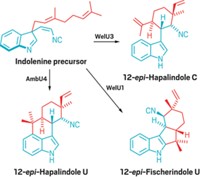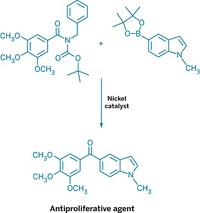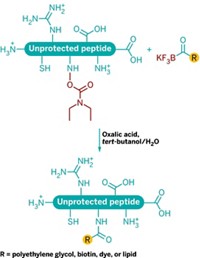Advertisement
Grab your lab coat. Let's get started
Welcome!
Welcome!
Create an account below to get 6 C&EN articles per month, receive newsletters and more - all free.
It seems this is your first time logging in online. Please enter the following information to continue.
As an ACS member you automatically get access to this site. All we need is few more details to create your reading experience.
Not you? Sign in with a different account.
Not you? Sign in with a different account.
ERROR 1
ERROR 1
ERROR 2
ERROR 2
ERROR 2
ERROR 2
ERROR 2
Password and Confirm password must match.
If you have an ACS member number, please enter it here so we can link this account to your membership. (optional)
ERROR 2
ACS values your privacy. By submitting your information, you are gaining access to C&EN and subscribing to our weekly newsletter. We use the information you provide to make your reading experience better, and we will never sell your data to third party members.
Synthesis
Science Concentrates
April 11, 2005
| A version of this story appeared in
Volume 83, Issue 15
A versatile strategy based on copolymer cross-linking enables the surfaces of a wide variety of metals, metal oxides, semiconductors, and polymers to be modified (Science 2005, 308, 236). Craig J. Hawker at the University of California, Santa Barbara; Thomas P. Russell at the University of Massachusetts, Amherst; and coworkers prepared ultrathin films of benzocyclobutene-functionalized random copolymers of styrene and methyl methacrylate, spin-coated them onto the surfaces, and then thermally cross-linked the copolymers (shown). The solvent-resistant films' thickness and surface properties, such as wetting, adhesion, and adsorption, can be tuned by changing the chemical composition of the copolymers. The films adhere to the underlying substrate without chemical bonding, the authors note. "This generalized route to surface modification does not depend on specific interactions or chemistries with the surface," Russell explains. "The independence from the nature of the substrate is critical for the fabrication of nanostructured materials for magnetic storage, field emission devices, and photovoltaic devices."
Finding the same toxin being produced by different species of cyanobacteria is relatively rare, but researchers have now found a toxin produced by most cyanobacteria. Paul A. Cox at the National Tropical Botanical Garden in Hawaii and coworkers find that the neurotoxic amino acid β -N-methylamino-L-alanine (BMAA, shown) is produced by 95% of the cyanobacteria genera and 97% of the strains that they tested, including species from all five morphological sections (Proc. Natl. Acad. Sci. USA 2005, 102, 5074). The samples included freshwater and marine species of free-living cyanobacteria as well as cyanobacterial symbionts from lichens and plants. The authors suggest that under the right conditions, all known cyanobacteria may be able to produce BMAA, meaning that there is a chance for widespread human exposure. BMAA, which was originally discovered in seeds native to Guam, has been suggested as the cause of a neurodegenerative disease that is widely found among the Chamorro people of Guam and has been tenuously linked to Alzheimer's disease.
A high-throughput method has been developed for identifying compounds with promising bioactivity based on their effects on cells [PLoS Biol., published online April 5, dx.doi.org/10.1371/journal.pbio.0030128]. The technique, developed by Kevan M. Shokat and coworkers at the University of California, San Francisco, in collaboration with a group at Cytokinetics, South San Francisco, uses the company's Cytometrix automated imaging and analysis system to monitor cellular effects of compounds from small combinatorial libraries. The system classifies small-molecule-induced changes in cell size and shape, organelle structure and position, fluorescence stain intensity, and other observable properties. Shokat and coworkers used the system to identify a new type of enzyme inhibitor and probe the mechanism of its enzyme target (carbonyl reductase 1), revealing a previously unknown role of the enzyme in apoptosis. By providing a direct window on the effects of compounds on cells, the technique enhances the feasibility of discovering novel bioactive agents "in a single screen with only a limited collection of small druglike molecules of limited chemical diversity," the researchers note.
A new fluorescent sensor based on a protein from a bacterium that thrives in a brew of toxic heavy metals has an unprecedented affinity for lead. In addition to its potential as a lead detector, this protein, with its unusual sensitivity, could be used to develop more selective chelating agents for treating lead poisoning (Angew. Chem. Int. Ed. 2005, 44, 2). Chuan He of the University of Chicago and colleagues created the sensor using a strategy they've devised for detecting other metals (C&EN, Jan. 26, 2004, page 41). The bacterium Ralstonia metallidurans produces a DNA-binding protein, PbrR, that's been known to be involved in allowing the bacterium to survive in a lead-rich environment. The group prepared a strand of duplex DNA that contained the PbrR-binding sequence and a fluorescent base. When lead ions and PbrR are added to the mix, the protein complexes with the lead and binds to the DNA duplex, causing the DNA to distort and the fluorescent base to fluoresce. In developing the sensor, the authors discovered that the protein binds lead 1,000 times more strongly than other heavy metals.
The planar-chiral heterocyclic compound shown effectively catalyzes the enantioselective coupling of phenols and ketenes to form esters, according to a new study (J. Am. Chem. Soc., published online April 5, dx.doi.org/10.1021/ja0506152). With the catalyst, Gregory C. Fu and Sheryl L. Wiskur of MIT prepare ∝-aryl esters from aryl alkyl ketenes and 2-tert-butylphenol in yields of up to 97% and enantiomeric excesses of up to 94%. The compound has been used as an enantioselective catalyst for various reactions but typically acts as a nucleophile, Fu says. In the new chemistry, the compound is protonated by the phenol; in protonated form, it serves as a chiral Brnsted acid catalyst. The ester products themselves are not of primary interest, but their hydrolysis products are, Fu says. Many∝-arylalkanoic acids, such as ibuprofen and naproxen, have biological activity, he points out. "It is important to have good, general methods for the catalytic enantioselective synthesis of ∝-arylalkanoic acids, and this work reports progress toward that objective."








Join the conversation
Contact the reporter
Submit a Letter to the Editor for publication
Engage with us on Twitter